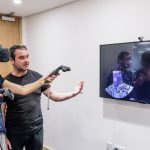 Virtual reality has been deployed in increasingly interesting ways in healthcare in the past few years, but one of the more novel applications comes from Oxford University, where researchers have been using VR to help compile genetic data that will eventually create models to explain how genes are controlled.
Virtual reality has been deployed in increasingly interesting ways in healthcare in the past few years, but one of the more novel applications comes from Oxford University, where researchers have been using VR to help compile genetic data that will eventually create models to explain how genes are controlled.
The simulations take data from genome sequencing, the interactions of DNA and from microscopy data. Combined, the team believe this enables them to provide a complex, three dimensional and interactive images of how regions of the genome sit in relation to others, and also how these regions interact with each other.
“Being able to visualise such data is important because the human brain is very good at pattern recognition – we tend to think visually,” the team say.
The team worked with researchers from Goldsmiths, who had been working on an application, called CSynth, to model proteins in 3D.
The working of genes
The work is crucial, as whilst we have become expert at sequencing the 37 trillion cells in the average human, less is known about how our genes are expressed, and this is crucial in better understanding the numerous genetic diseases humans suffer from.
“There are more than three billion base pairs in the human genome, and a change in just one of these can cause a problem. As a model we’ve been looking at the human alpha globin gene cluster to understand how variants in genes and their regulatory elements may cause human genetic disease,” the researchers say. “Applying this to other diseases is more difficult because it can be difficult to link a faulty switch to the gene it link the gene it regulates. ‘By combining data on the genome sequence with data on gene interactions we can create a 3D model that shows where regulatory elements and the genes they control sit relative to each other, and it makes it easier to understand the processes going on within a living cell.”
The team hope to apply these various techniques to aid their study into genetic diseases such as diabetes and multiple sclerosis. It’s part of a wider body of work that is using new technologies and techniques to examine how DNA is packaged and how gene expressions are regulated.
Ultimately, the researchers hope to be able to correct faulty genes, with the corrected cells then re-introduced into the bone marrow of the patient. Before that’s possible however, a much better understanding of the genes is required. They hope that VR will play a crucial role in this by allowing data to be efficiently combined.
It’s a fascinating project, and you can learn more about it via the video below.